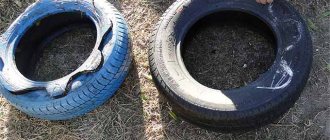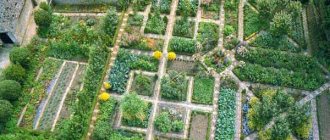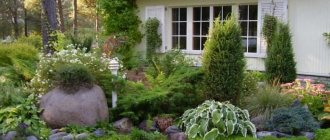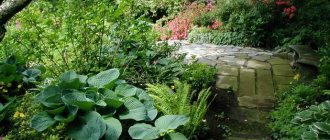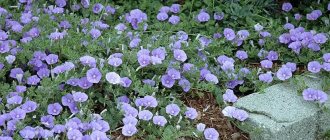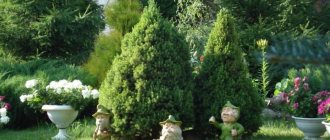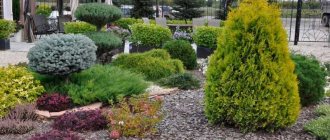Most gardeners want to see their plot aesthetically attractive, when beauty and benefit are inseparable. The article will talk about special border tape, with which you can elegantly decorate beds and flower beds to achieve the appropriate effect.
What is border tape and what are its advantages?
A special strip, which can be used to frame beds in the garden and vegetable garden, can now be found in any garden center. It is made mainly from plastic. You can find a wide variety of colors, but most often they are black, green, brown and khaki.
Advice. If you plan to frame the garden bed inconspicuously, then a brown tone is most suitable. Bright colors are best used as a separate flowerbed decoration.
The width ranges from 10 to 50 cm. The second is ideal for decorating multi-tiered compositions. The thickness is usually about 2 mm. The tape is sold in rolls from 10 to 50 m long. It can be strongly or weakly corrugated in shape, have a carved edge, etc. The direct option is most in demand.
Border tape
The advantages that curb tape provides are as follows:
- The tape is endowed with significant flexibility, so it can be used for beds and flower beds of various configurations, and not just for framing strict round or rectangular shapes.
- Comparatively cheap. Plastic edging will cost much less than edging with other materials, such as metal, wood, concrete, etc.
- It is very easy to install such a border yourself, and it will take very little time. If necessary, it can be removed just as quickly.
- The tape has the advantage of being durable. Plastic is not subject to corrosion and does not fade.
- This type of fencing holds the shape of the garden bed remarkably well. It is environmentally friendly because it does not decompose and does not release harmful chemicals into the surrounding soil.
- Border tape is universal. In addition to its direct purpose, it can be used to protect concrete and stone paths from spreading. It is also used to seal greenhouses and greenhouses.
How to choose the right option and install the tape correctly
When choosing from a large assortment, you first need to decide on the purpose. If you plan to create a stepped composition of flower beds or beds in the form of terraces, then it is better to purchase a wide format. The deeper the tape is dug, the more securely it will hold the soil.
Attention! The highest quality options are those with reinforced edges.
To install the border you will need the following:
- marking tools (tape measure, cord and pegs);
- border tape;
- bayonet shovel.
The actual installation is carried out like this:
- Using a tape measure, cord and pegs, mark the boundaries of the future bed.
- Using the markings, dig a groove of a certain depth. For example, if the width of the strip is only 10 cm, then the soil at the installation site can simply be loosened well. With a border of 25 cm, you will need to deepen it at least 20 cm.
Advice. It is better to limit a bed with perennial plants to wide ribbons.
- A strip is installed in the groove. With the narrow version, it is simply stuck into loose soil. At the same time, there should remain from 2 to 5 cm above the ground surface.
- The border is well tensioned. To do this, pegs are installed in the corners and bends.
- If you need to connect the edges, they overlap each other.
- The fence is vertically leveled and sprinkled with soil on the sides. Finally, the soil around is well compacted.
Advice. If you need to connect sections of the strip, this can be done using a soldering iron or burner.
How to decorate beds with a border and how to care for it
The simplest option for decorating beds is a piece of ribbon sewn into a ring. They do it like this:
- The required length is stapled into a ring.
- They dig into the ground.
- The resulting side is pulled well at the corners using pegs.
Similarly, you can use edging tape to create raised beds. However, in this case you will need a frame made of wooden or metal pegs. The tape itself is dug into the ground at least 10-15 cm.
Organizing uniform watering of beds located at an angle is also possible using a border made of plastic tape. To do this, you will need to dig a wide (20-30 cm) ribbon along the edge of the ridges and strengthen it with wooden stakes, metal or plastic pipes. You can also divide the sloping bed into small sections with tape. As a result, water will be retained and distributed evenly throughout the soil.
Based on the opinions of gardeners and the photos they attached to the reviews, we can conclude that using border tape you can easily frame flower beds, alpine slides, ponds, paths, etc. Equipped in this way, they always keep their shape and are not washed out by water. And the trunk circles of trees and shrubs decorated with plastic immediately give the garden a neat, well-groomed appearance. The border does not require any special care. It is resistant to frost and heat, and is not afraid of high humidity during prolonged rains.
The only thing you need to do after installation is to monitor the load. For example, it is extremely undesirable to step on the frame with your feet or run over it with a lawn mower. This can cause the plastic to go very deep into the ground or simply break, which will disrupt the overall picture.
Border tape is a universal material, so the popularity of its use is growing every day. With this simple and inexpensive device, you can quickly create the desired composition and transform the entire area.
How to use border tape in the country: video
Modern horticultural culture involves not just cultivating the land to obtain the greatest harvest, but also creating an aesthetically attractive garden in which beauty and benefit are one whole. A well-groomed area with beautiful paths, garden sculptures and shaped beds is an ideal example of designing a summer cottage. All this beauty requires constant care, so any summer resident will need small tricks and modern materials to make the task easier. One such material will be discussed in the article. Meet: border tape for beds. What is it useful for, what types of garden border strips are on sale and how to install this device correctly?
A neat strip of durable plastic will clearly outline the boundaries of the flower garden
Colors and texture
The width of the strip varies from ten centimeters to half a meter. High borders are used to form multi-tiered structures. The thickness of the material is from one to two millimeters.
The thicker the material of the tape, the stronger it holds the bulk soil.
Border tape for beds is packaged in rolls. The footage can be from ten to fifty meters. The texture of the stripes also varies. You can find a ribbon with waves or corrugated, like an accordion; there are options with a figured and carved edge. The simplest and most common texture is the usual straight line. Borders come in green, brown, yellow, gray and black.
Pegs are used to securely fasten the strip
Brown ribbon looks most natural. It is not conspicuous and neatly limits. White, green and yellow specimens will be very noticeable, so they are used if a flowerbed with a special decoration is planned.
Benefits of use
What are the benefits of using border tape for beds?
| Arrangement of flower beds of complex configuration | The tape is extremely flexible; it can be used to decorate not only square or round flower beds, but also flower beds of complex shapes |
| Low installation costs | Plastic is inexpensive, especially in comparison with concrete, brick and metal curbs |
| Easy to install | To install the tape, you do not need to involve specialists; you can simply install it yourself in a matter of minutes. If necessary, the tape can also be easily and quickly removed |
| Durability | Plastic borders do not rot, do not fade and keep their shape well for many years |
| Use for different purposes | Plastic strips can be used not only for decorating vegetable plantings and flower beds. They are installed to protect paths and building formwork from moisture, and they are used to seal greenhouses. |
Consumer Reviews
Irina, 32 years old, Nizhny Novgorod: “I’ve been using plastic tape for a long time, I’ve made good flower beds. the structures do not require much maintenance. Sometimes you have to wipe away dirt after precipitation, but in general everything is very simple and convenient. The pleasure is incredible and the beauty indescribable. I use different colored restraints, which make the environment more fun and carefree.”
You can make a border for your garden beds yourself. Read the article “Do-it-yourself border for garden beds.”
Watch the video! Border tape
Where can you use decorative borders for flower beds?
Flower beds of various structures, including multi-tiered structures, are created from corrugated plastic strips.
Advice! To create a stepped flower garden, create levels step by step.
First, the first tier is fenced off with tape, then a new border is made in the center of the tier and filled with earth. For these purposes, strips from twenty centimeters to half a meter wide are used.
Formation of a multi-tiered flower bed
Places of application of plastic borders:
- Flower beds. With the help of tape, clear boundaries are created and the flowerbed does not spread out after rains.
Flower garden with plastic fence
- Rock gardens and multi-tiered flower beds and beds. The tape is indispensable if it is necessary to raise the soil level. Thanks to its flexibility, multi-level structures look very natural.
Using tape, clear boundaries are drawn for the colored backfill.
- For fencing lawns. The clear boundaries of the green area, outlined with green plastic tapes, look attractive and neat.
An example of using a fence on a lawn
- For decorating beds. On hot days, the soil dries out so much that when watering, water spreads beyond the plantings without having time to be absorbed into the ground. The fence will help retain moisture within the garden bed.
Decorating plantings in the garden with plastic
- Paths. Decorating paths with tape will not only make them neat and beautiful. The tape will prevent gravel or other decorative topping from extending beyond the path. In addition, it will protect the paths from weeds.
Example of design of an embankment path
- Other household needs. Using plastic, you can close the cracks at the bottom of the fence, make compost, and raise garden strawberries above the ground.
The scope of application of the tape is very wide. You can buy borders for flower beds at any garden store.
Related article:
Beautiful garden beds at the dacha with your own hands. How to apply a scientific approach and build beautiful garden beds with your own hands, photos and descriptions of the processes are in this article.
Features of arranging paths between beds
When choosing a method for designing row spacing, you should not completely identify them with the paths that are laid across the site for constant movement, since they have a slightly different structural design. Garden paths are arranged as a permanent element of the site, but row spacing can sometimes change their location.
If possible, the covering of the passages between the beds is made removable - it becomes possible to change the layout if necessary
Some owners create permanent beds in their home areas, similar to flower beds, laying concrete or tiled paths around them. However, this option is not entirely rational, since the soil in the beds is gradually depleted, and even if it is actively enriched with various fertilizers, it will have to be changed periodically, removing the old layer and filling it with fresh soil. If the row spacing is filled with concrete, then this area can no longer be used as a garden bed. In addition, concrete does not allow the soil to breathe normally and excess moisture to evaporate, which can negatively affect cultivated plants growing in beds next to such a covering.
Therefore, zealous gardeners, who take care of every piece of land on their acres, prefer paths that, if necessary, can be moved to another place, for example, swap them with beds when planting a vegetable garden next spring.
Taking these conditions into account, it can be assumed that ready-made covering material that meets all the above criteria, or a well-thought-out scheme for arranging such row spacing, thanks to which they will be met, will be suitable for garden paths.
The principle of arranging passages between beds is quite simple. It can be divided into several successive stages:
This “light” version of the path can always be easily dismantled and moved to another area of the garden.
How to choose garden border tape
Before you buy garden border strips, you should decide for what purpose you plan to use them. The width of the stripes is 10, 15, 20, 28-50 centimeters. To create stepped compositions, it is better to purchase wider strips; the deeper they are dug into the ground, the more securely the tier will hold.
Stripes for decorating flower beds are produced by Chinese, Polish, German and Russian manufacturers. According to users, Chinese and Polish material is too soft and does not hold the borders of the beds tightly. Domestic plastic is not of good quality and can be fragile. German curbs with reinforced edges are considered the highest quality.
All borders are resistant to precipitation and can withstand temperature changes from minus to plus fifty degrees. Their material does not decompose and releases toxic substances into the soil
How to properly install plastic borders for flower beds
The plastic tape is extremely elastic. It can bend, repeating the most intricate shapes. Quite thin, it can be easily cut with ordinary household scissors. The strips can be fastened together by welding with a regular soldering iron or even a burning device.
You can install the tape alone, but it is much more convenient to do it with a partner
Installation algorithm:
- Using a tape measure, cord and pegs, the future flower garden is marked.
- A groove is dug along the marking lines to the required depth. If the tape is narrow - 10 centimeters, there is no need to dig a groove, just loosen the soil along the contour. A flowerbed with perennials should be limited by a border at least twenty-five centimeters high, twenty of which should be buried in the ground.
- The tape is installed in the prepared trench. The narrow strip is simply stuck with its edge into the loosened soil. To properly tension the strip, use stakes. They are installed at bend points. The edge of the strip should protrude above the surface by two, maximum five centimeters.
- After installation, the tape is sprinkled with soil. If the flowerbed is round, the edges of the border are placed one after the other, making an overlap.
Installation of plastic fencing
If you buy borders for garden beds made of plastic with one reinforced edge, when installing it, it is placed on top.
Why is it necessary to cover paths?
There are several reasons for high-quality arrangement of paths with one or another coating. Most of them are well known to the owners of the plots, but still they are worth identifying again.
All the negative aspects mentioned above in no way improve your mood, since even having vegetables, berries or herbs “at hand”, it is quite difficult to collect them from the garden both during rain and for quite a long time after it. Therefore, you will have to wait until the soil dries and is not slippery and sticky.
In a word, high-quality paths between the beds should be the goal of any self-respecting gardener.
Caring for borders for plastic beds
Caring for the tape is not difficult. It is resistant to temperature changes and immune to humidity. Flexible plastic is stored in rolls. Care must be taken to ensure that the tape does not break during storage.
Although the plastic border is not afraid of frost, in winter it is better to sprinkle it with snow along with the flower bed. This way you will protect both the fence and the perennials from freezing. German manufacturers offer lawn mower resistant tapes. But it’s better not to take risks and carefully trim the grass in the area where the fence is located. Try not to step on the tape; it may become too deep under your weight or simply break.
Alternative: galvanized border for garden beds
Galvanized metal is known to be corrosion resistant and highly durable. Products made from it can last twenty to thirty years. The only drawback of this material is that in an aggressive environment, zinc interacts with other chemical compounds and its sulfate gets into the soil, and then into the plants.
To avoid such a reaction, modern manufacturers produce galvanized curbs, additionally coated with a polymer compound. The material protected in this way is not afraid of fertilizers and acidic soil.
The polymer coating can have any color: from yellow to black
You can choose a border with a polymer coating that imitates wickerwork, stone or wood. On average, the service life of such material is about forty years.
Advantages of galvanized curbs:
- long service life;
- compactness;
- height from 20 centimeters;
- ease of installation;
- great appearance.
A galvanized border will become an insurmountable barrier for rodents along the perimeter of the greenhouse and will protect the area from the penetration of small animals under the fence. You can safely attach watering hoses to it and fix geofabric.
Criteria for choosing coverage for paths between beds
To figure out which covering option for a garden path will be optimal, you first need to understand what criteria it must meet. “Indiscriminate” use of everything that comes to hand can lead to the material of the paths seriously harming the crop.
So, the coating must meet the following requirements:
To make it easier for readers to choose a method for making paths in the garden, options for arranging them will be considered below.
Reviews and price of border tape for beds
As already mentioned, you can buy plastic borders for garden beds at any garden store. The cost of a roll depends on the footage and width of the tape. Here are the average prices for rolls of 10 meters:
| 10 | To limit embankment paths and platforms, create upper tiers in flower beds, and form landscape compositions | 320 |
| 15 | To delimit beds and create alpine slides | 470 |
| 20 | Zoning of landscape compositions, limiting the growth of the root system by seedlings of trees and perennial plants | 620 |
| 30 | Formation of multi-tiered structures, installation along the fence to prevent the penetration of small animals and weeds | 930 |
Many gardeners have been using border tape for their beds for a long time. Reviews of this material note positive and negative aspects of use:
Irina, 34 years old, Rostov-on-Don: “I have been using plastic tape for flower beds on the site for a long time. It doesn’t require any special care; I wipe it down from time to time, especially after rain, but otherwise no hassle.”
Yana, 40 years old, Tver: “I didn’t like the use of plastic tape. We often mow the lawn with a trimmer. We touch it all the time, the edges crumble, it doesn’t look good. I had to remove it completely and replace it with a brick border.”
Olga, 26 years old, Kaluga: “We bought the dacha relatively recently, and I just started creating flower beds. At first I made them small, and then gradually increased them. Everything is simple with the tape - take it out of the ground and grow it to the required size. I can’t even imagine how much of a hassle it would be with a brick or concrete curb.”
Susanna, 37 years old, Belgorod: “I used ribbon for planting tulips. There were some rodents in the area and they ate almost all the bulbs. I planted each onion in a ring of ribbon. This is the second year that all the tulips are blooming.”
Which width to choose?
You need to choose border tape for beds based on density. It should be strong, dense and, at the same time, elastic. Try to wrinkle, bend, stretch the sample. Nothing will happen to a good quality plastic edging.
The choice is wide, but we immediately omit the cheap options
You should immediately discard cheap options. They are usually thin, do not hold soil well, and can break and crumble. It’s simply not worth spending money on them - after the first winter there is nothing left of them. Only fragments of plastic that no longer hold anything and only spoil the appearance.
You need to choose a border tape from at least the average price range. It comes in different widths - from 10 to 60 cm. The width is selected based on the area of use:
These are by no means mandatory recommendations. The data was collected based on the results of use, based on feedback from those who have already used plastic curb tape. You can experiment yourself or voice your experience in the comments.
Width may vary. We select it depending on the intended use
If you plan to use a lawn mower or trimmer for row spacing, use the thickest tape you can find. It will spring back during a collision, nothing will happen to it. The density can be determined by touch, but what to do if you are going to buy online? How to determine how thick the tape is? The first indicator is thickness. Some manufacturers indicate it. The second is mass. The more a roll of the same width and length weighs, the greater the density of the plastic. Well, of course, you can read the reviews. Usually the negative aspects are described and you can understand how suitable this type is for your purposes.
How to make a border for a flower bed with your own hands: photo ideas
You can fence a flower garden without plastic tape. There are several options for arranging a fence:
- The edges of the flower bed are decorated with a groove . It is dug to a depth of ten centimeters, cleared of roots and debris and covered with decorative material: colored chips, pebbles, shells. Such a fence must be constantly maintained.
To decorate flower beds, you can choose colored material
- Mosaic fencing . You can use fragments of colored bottles and broken plates for it. To secure parts of the mosaic, a cement-sand mixture is used.
Mosaic design of a mini-flower bed
- Stone fencing. To create it, just find flat stones and dig them around the perimeter of the flowerbed. This border looks very natural and is suitable for any type of flower garden. You can fence the flowerbed with marble, granite, sandstone and limestone. The stones do not have to be fastened with cement, but it will help firmly fix the elements of the fence and prevent soil from spilling through the cracks.
Large stones will give the flower garden a special flavor
- Weaving. Fences made of willow twigs look very colorful. It's not difficult to do. You need to drive wooden pegs into the ground at equal distances from each other. Then simply intertwine them with willow twigs. To prevent the ends of the vine from sticking out in different directions, they are tied together or fastened with small screws. To preserve the structure for a long time, it can be varnished.
Wicker fences look like baskets
- Living fence. You can also fence a flower bed with tall plants with a hedge. It is formed from low plants, up to forty centimeters high. They are planted in a dense row. The composition looks beautiful, contrasting with the main plants in the flower garden.
Lavender, boxwood, hostas, and carnations are planted as a living fence.
Materials for forming paths between beds
Now we need to consider the materials used to create paths between the rows of the beds.
Substrates for coating
Several different materials can be selected as a layer that will cover the soil from the sun's rays - geotextiles of a certain thickness, black plastic film, roofing felt, as well as sheets of cardboard or even old newspapers laid in several layers.
Prices for geotextiles
What is geotextile?
Many of the owners of country plots are probably not even familiar with this name, not to mention information about the advantages of the material itself. A special article on our portal will help fill this gap - it will tell you in detail what geotextiles are and how they are used .
Path covering
Bulk building materials, such as shavings, sand and fine crushed stone, can be laid on the substrate as a protective layer. It is practiced to lay stone or concrete tiles, which, however, are not permanently installed, that is, the seams are not sealed with concrete mortar, but are simply covered with sand. In addition, special plastic and rubber slabs, as well as roll coverings made from crumb rubber, are produced for the construction of paths. The finished products meet all the necessary requirements for outdoor use.
The lids can be combined to create a specific design or pattern - for this purpose, parts of the required color are specially selected and an ornament is made from them according to the sketch. If there is no artistic streak, then nothing prevents you from fastening them together chaotically - the result will also be a very entertaining picture. The lids should not be tightly pulled together, but they should not hang loosely either. If they are fastened relatively loosely, then the resulting “carpet” can be easily rolled up and moved to another place.
This covering is laid on a geotextile backing, which will prevent the germination of weeds, and the covers will create an outwardly interesting and convenient path. It should be noted that it is pleasant to walk on such a surface barefoot, so some craftsmen make massage mats for feet from the covers. If you like this idea of arranging paths, then you need to start collecting covers without delay, since you will need a very large number of them.
Prices for paving slabs
Rubber tile coating is used not only for garden paths - it is intended for arranging car areas, floors in garages and industrial workshops, and based on these factors we can draw a conclusion about how durable and reliable the material is. The tile does not slip, as there is a relief pattern on its surface. It is made from environmentally friendly ingredients, so it does not emit harmful substances and will not negatively affect the quality of vegetables. In addition, the rubber does not transmit light to the ground, so weeds will not grow on the path. However, rubber tiles do not allow moisture to pass through, so they must be laid in such a way that water flows off the surface to the sides. The standard dimensions of the tiles shown as an example in the illustration above are 550x550 mm, the thickness may vary, but it is best to choose options at least 20 mm thick. Rubber tiles are usually equipped with locking joints, which is very convenient - after installation, even under load, the coating will not spread.
The material is resistant to wear and temperature changes, so it does not need to be removed from the garden for the winter. The coating is not subject to mechanical damage and rotting. In a word – sheer advantages!
Garden path tiled with rubber crumbs
Installation of roll and tile coverings is very simple - they are laid on a well-leveled soil surface, cleared of weed roots and compacted, without the use of a substrate. Under the influence of temperature changes, from negative to extremely high, which can occur on the soil surface, the coating does not soften or dry out.
Roll coverings are produced in widths of 500 and lengths of 3500 mm. Its thickness may vary, but 10 mm is enough for arranging paths.
Rubber tiles can have different configurations, but they always fit perfectly together, creating a durable coating due to interlocking connections.
Any coating made using this technology is not only practical, but also very aesthetically pleasing. Paths made with this material look neat and are very pleasant to walk on.
The only drawback of any crumb rubber coating is its rather high price.
The wear resistance of this coating is ensured by the primary polypropylene used for its manufacture. It is odorless and does not emit harmful substances into the environment, so the material can safely be called environmentally friendly. Another manufacturing option is also made from completely safe polyvinyl chloride (PVC).
Prices for molds for making tiles
The modules are connected to each other using special clamps that come with them.
The advantage of all ready-made coverings, both roll and modular, is their simple and quick installation and dismantling, which is especially important if it is necessary to arrange paths in a country house that is used only in the summer. In the absence of the owners, ill-wishers may visit the site and are able, so to speak, to borrow the coverage for their own needs. Therefore, in the winter, it is best to collect the modules or mats from the paths, wash, dry and put them away in the premises of outbuildings.
At the same time, in areas with permanent residence, row spacing is left covered year-round, since the material is designed for use at both low and high temperatures.
Compost paths
It is impossible not to mention the compost paths between the rows, which are arranged by experienced gardeners. There is even a triple benefit here:
The work of arranging such paths is quite labor-intensive, as it requires physical effort. However, gardeners are no strangers to digging up beds. So, measures to create compost rows are carried out in the following order:
It is best to arrange compost rows in the fall, when there is a lot of plant material. In winter, snow will cover the geotextile, and inside the ditch it will be warm and humid, which is very important for the quality functioning of the created bio-environment, which will do most of its “work” during the autumn-winter period.
Next fall, when the compost is ready, the beds and row spacing can be swapped and compost paths created in the place of the former beds. In this way, the entire garden is gradually fertilized.
Prices for plastic tiles for garden paths
Compost is perhaps the best fertilizer for the garden!
And what is most important is that it can be obtained in the required quantities practically for free, only by making certain efforts and creating the necessary conditions for this. And one of the conditions is a well-equipped compost pit , the variety of designs of which and methods of their installation are described in detail in a special article on our portal.
Let's summarize. Obviously, if you wish and have time, the paths between the beds can be made independently, without resorting to outside help. Moreover, as a last resort, for this purpose you can use improvised materials that can always be found on the site. In addition to regular paths, it would be most practical to make compost paths - this way you can significantly save on fertilizers and get high-quality environmentally friendly compost without chemical additives. In this case, the paths will not only create comfort when working in the garden, but will also help you get a rich harvest.
Making your own border for a garden bed from scrap materials
The main requirement in decorating a flower bed is well-groomed. Orderly planting completely changes the look of the garden. If lumber remains after construction, it can be used to fence plantings. The remaining boards can be cut into equal lengths or joined together.
Covered with stain or paint, such fences will reliably strengthen the walls of the garden bed
If desired, you can use old solid brick for this purpose. It must first be thoroughly cleaned. To make the bricks look aesthetically pleasing, they can be painted one color or made multi-colored.
Flowerbeds made of old bricks
Another building material that is often on hand is slate. Its segments are installed so that the edges are at the same level. For an elegant look, the edges of the slate can be painted.
Example of using slate
Rubber from car tires. Small flower beds can be made directly in the tire by filling it with soil. If you cut off the rubber strip, it can also be used for shaped beds.
Flowerbed of car tires
You can use leftover polycarbonate to decorate your garden beds. It is cut into strips of the required width. Polycarbonate is not as soft as plastic tape, but it can be used to enclose plantings of the correct shape.
The most easily accessible material for country crafts is plastic bottles. They usually end up in the trash, but it turns out they can be used for garden beds. The containers should be filled with sand and placed neck down in one row.
This border can be painted in any color.
Advice! Do not use pieces of sheet metal for fencing. You can accidentally cut yourself with it, and, in addition, without a polymer coating, the iron will quickly rust. The sun's rays reflected from shiny metal can cause burns to the delicate foliage of plants.
Homemade borders
For those who like to make decorative elements from scrap materials, there are many ideas for decorating their backyard areas and arranging a lawn or flower garden. Let's see what we can replace the curb tape with.
The simplest option for creating a garden bed or flower bed is to cut out a fence from a car tire or frame it with colored plastic bottles.
Here are some original photos with examples of fences for garden beds created by yourself:
- fencing made from improvised means;
framing with plastic bottles;
living frame of low-growing bushes;
border of colored bottles.
Let's learn in more detail how to make a border for a flower bed from bottles. Such fences are very popular among summer residents.
Bottle fencing
There are many ways to create border structures for flower beds from colored plastic bottles. Such containers differ in configuration and size, which opens up great opportunities for landscape design.
Consider the idea of vertical arrangement of 1.5 liter bottles.
Step-by-step instruction:
- Remove the stickers from the container and wash it thoroughly, then dry it. To make the bottles stronger, fill them with sand, pebbles or other filler.
- Make grooves around the perimeter of the flower bed, about 10 cm deep and wide enough to match the containers.
- Place the containers vertically, pressing them as tightly as possible, then sprinkle with earth.
A video will help you cope with this task, demonstrating step by step the creation of a homemade fence for a garden bed made of bottles:
Homemade stone fence
If you decide to spend money and decorate your garden area with stone, you can create a fence for your garden beds from this material yourself.
On a note! To create a stone border, you can use stones left over from the construction of a house or other structure: the main thing is that they have a neat shape.
Step-by-step creation of a stone border for a flower bed:
- Make markings on the selected area: to do this, use a rope and wooden pegs.
Prepare a groove for the foundation approximately 30 cm deep, cover it with cellophane or roofing felt and fill it with cement-based mortar. After the mortar has dried, make masonry (you need to start with large stones, adjusting them to size). Seal the gaps between the stones with cement, adding gravel to the solution for greater strength.
Important! When arranging a stone fence, leave cavities for ventilation. For the outer layer, use smooth stones. Pour soil into the flower beds and plant flowers.
It’s not difficult to make a stone flowerbed with your own hands, the main thing is to do the laying correctly. Stone structures are durable - this is one of the main advantages of such fences.
Watch a video teaching how to create a flower bed from stone:
https://youtube.com/watch?v=g4IngPCbjbc
And yet, using a border strip to frame beds is the easiest way to create a presentable landscape decor. Such products help to fix fertile soil and strengthen the fertile layers of the soil.
The configuration, size and color range of plastic borders is varied, it is not difficult to find a suitable option. And the long service life and durability of the product eliminate the need to redo the bed or re-arrange the flower bed or path every year.
The photo shows an example of flat beds for planting any plants:
Create a presentable landscape decor in your garden using a practical and inexpensive material – a plastic border strip. It's easy to install the tape yourself. Such fencing for beds, flower beds and paths will last a long time.
Model bed
Neat design of the garden bed already makes it attractive. Plastic curb tape is a cheap material that is easy to install yourself. Such a fence will last quite a long time if you use a lawn mower carefully and cover the bed with snow for the winter.
A strip of plastic is an inconspicuous and reliable fence
An alternative to plastic tape can be curbs made of galvanized steel with a polymer coating. You can make fences from available materials: old tires, scraps of lumber, slate and brick. Give free rein to your imagination and turn a boring vegetable garden into a park area!
